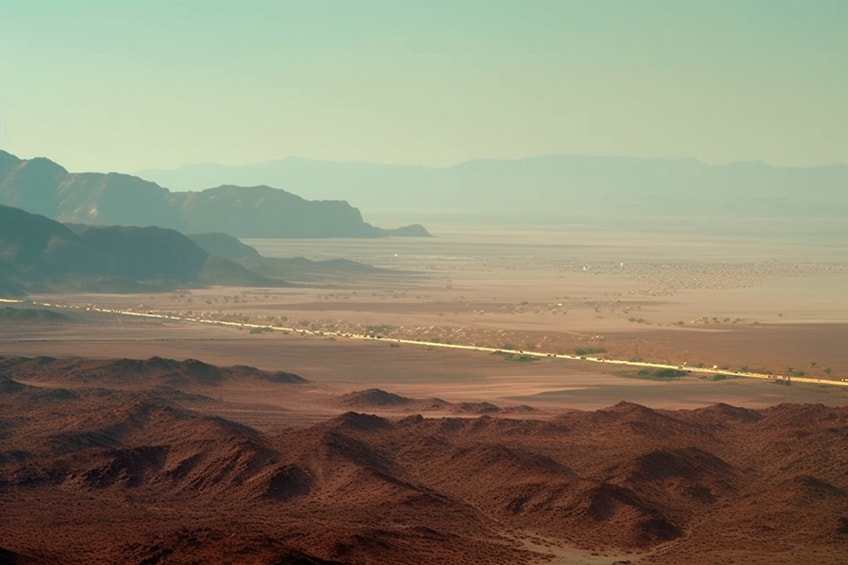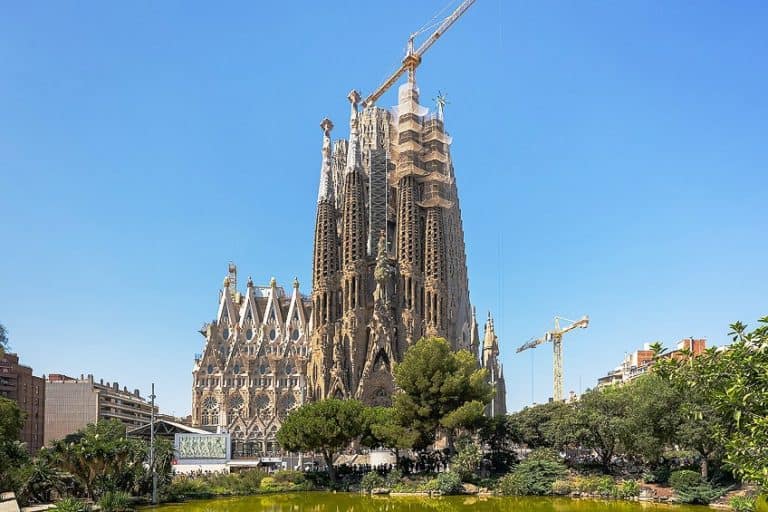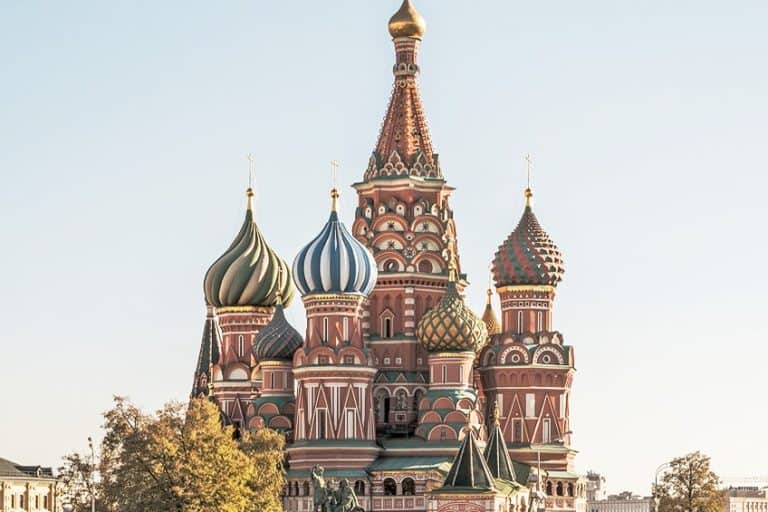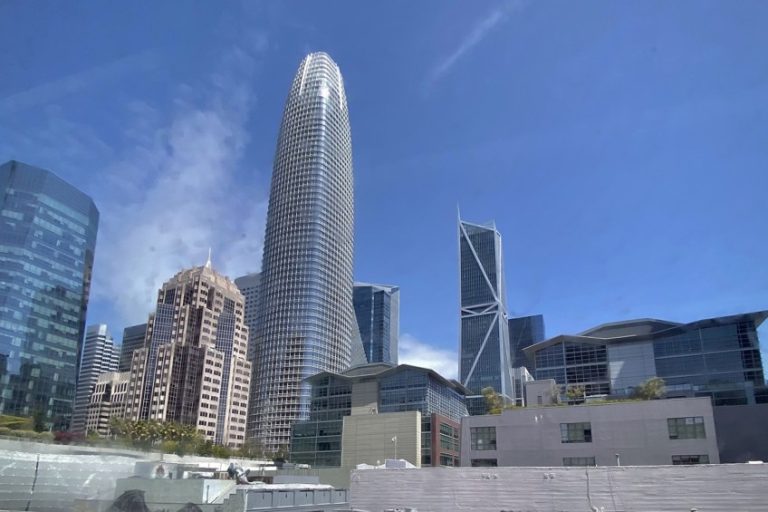The Line Saudi Arabia – The New City in Saudi Arabia
The Line in Saudi Arabia is being designed as an ultra-modern smart city that will have no cars, streets, or carbon emissions. Currently under construction in the city of Neom, Saudi Arabia’s Line city will be 170 kilometers long and will create approximately 460,000 new jobs. By October 2022, construction had begun along the entire length of the new city in Saudi Arabia.
The Construction of The Line in Saudi Arabia
| Architect | Studio Morphosis (est. 1972) |
| Function | Smart city |
| Dimensions (km) | 170 (length) |
| Location | Neom, Tabuk, Saudi Arabia |
Saudi Arabia’s Line City has already faced major criticisms regarding its potential impact on the surrounding environment, its effect on the local inhabitants, and the viability of its technology. However, the designers say that the 170-meter-long new City in Saudi Arabia will preserve 95% of Neom’s nature. The Line stretches all the way from the Red Sea to the city of Tabuk.
Proposal of the New City in Saudi Arabia
The Line in Saudi Arabia is planned to have nine million residents, giving it a population density of 260,000 for every square kilometer. In comparison, the world’s most heavily populated city, Manila, had a population density of 44,000 people per square kilometer in 2020. The Line’s design consists of two mirrored structures divided by an outdoor area in the middle, with a height of 500 meters and a width of 200 meters. The power for the city will be generated purely by renewable energy and will be divided into three layers: one for pedestrians on the top, one for infrastructure underneath, and a third for underground transportation. A. I. systems will analyze the city and apply predictive and statistical models to identify ways to enhance inhabitants’ daily lives, with residents being compensated for providing data to The Line’s database.
The projected construction cost is somewhere between $100 and 200 billion, with some estimations reaching $1 trillion.
The History of Saudi Arabia’s Line City
Mohammed bin Salman, the Saudi Crown Prince, presented the proposal for the new city in Saudi Arabia in a presentation aired on state television on the 10th of January, 2021. Earthworks commenced in October 2021, with the first occupants scheduled to arrive in 2024. The first phase, however, was re-scheduled to be finished in 2030 as of July 2022. The Crown Prince, who also serves as Chairman of the NEOM board of directors, published a message and promotional video on the 25th of July, 2022, resulting in increased media attention to the project. This prompted concerns about the design’s benefits and environmental challenges, with detractors afraid that the project would produce a dystopian and unnatural complex that would uproot the Huwaitat indigenous tribe and disrupt wildlife and bird migration.
Drone footage indicated that construction on the city was proceeding, with excavation activity taking place over the full length of the site.
Criticisms of The Line in Saudi Arabia
Because of the enormous number of variables involved, some critics argue that achieving the smooth, futuristic look portrayed in concept art would be challenging in such large-scale urban planning. While Winy Maas, a Dutch architect, stated that he would love to live in such a location, he believes the concept art’s profile is boring and would cause adverse wind flow through the middle of the city. He did, however, applaud the general concept of dealing with issues of densification and heat regulation within the city. Another stated that while it may look good on paper, it would all come down to the quality of life, which would be determined by the city’s management, not its aesthetic appeal.
Despite its promises of zero carbon emissions, the development would have a carbon footprint of around 1.8 gigatonnes of CO2 equivalent in steel, glass, and concrete, because a 500-meter-tall structure cannot be built with low-carbon materials.
The 170-kilometer profile, as with highways, would form a large-scale barrier to nearby ecosystems and migratory animals, and the mirrored external facade would be harmful to birdlife. According to digital rights specialists such as Vincent Mosco, the city’s data gathering system might turn it into a “surveillance city”, due to circumstances that would confuse consent to share data and because Saudi Arabia’s abysmal human rights record may indicate possible data misuse.
According to Joseph Bradley, the CEO of Neom, the coordinators are tackling privacy and security issues, and Saudi Arabia has a personal data protection statute. Aside from the disadvantages of the proposed new city in Saudi Arabia, the government’s conduct in pushing the project was also questioned. Ibrahim, Shadli, and Ataullah al-Huwaiti of the Howeitat tribe were sentenced to be executed in October 2022 after refusing to leave their home as part of the NEOM megaproject.
Shadli was Abdul Rahim’s brother, who was killed by security personnel in April 2020 at his house in the Tabuk provincial area designated for NEOM after sharing videos on social media criticizing the relocation of local inhabitants to make room for the project.
Design of The Line in Saudi Arabia
Zero Urban Gravity is a term The Line’s designers use to refer to the reduced reliance on the natural ground plane by constructing many vertically oriented ground planes at various heights. They would effectively be creating a new topography around which city life is built. With this innovative design, the city’s physical footprint would be 2% of that of a traditional city with a comparable population. The designers regard NEOM, radical though it may be, as a workable solution to the progressive and deliberate invasion of natural ecologies and environments as the world’s population rises and urban migration persists.
Hyper Proximity
Hyper Proximity is defined as a phenomenon that brings more people together than ever before, fostering unparalleled social and cultural exchange. People will no longer be restricted to horizontal mobility, but can increase their access to other neighborhoods by traveling to levels above or below. Manhattan, is an example of a thriving high-density metropolis, with 25,000 people accessible within a 5-minute walk.
Anyone within The Line could reach 80,000 people in the same length of time while retaining the same density and comfort.
Hyper Mixed-Use
The concept of hyper-mixed-use refers to the idea that in this environment, we may find everything and anything. The Line is opposed to zoning and categorization – they feel that all elements of human existence, including work, culture, entertainment, and education, take place across the city. Other cities may not be able to create synergies between certain industries or areas, but The Line in Saudi Arabia intends to achieve both.
You can reach 80,000 people in 5 minutes, resulting in many mixed walkable business areas and ecosystems.
Access to Nature
The revolutionary morphology of Saudi Arabia’s Line City provides urban space that is one-of-a-kind. From all heights of the structure, everyone in the city enjoys a direct view of nature. Everyone gets direct access to nature on either side of the city, as well as several parks and pedestrian areas. It also gives people from all levels of society an equal opportunity to participate in all aspects of public services and facilities.
The decision of where to live will be based on personal desire and choice.
The Mirrored Facade
The mirror is a glass facade that allows you to see out. In addition to the light obtained directly from above, this glass will naturally allow sunshine in through the city’s sides. As the area within the mirrors is a mix of outdoor space, plazas, parks, and pathways, as well as internal public and private spaces, the facade will have numerous opportunities to enable the city to breathe. Their responsibility as planners is to quantify and choreograph the volume of light that passes through the city’s mass. Southern light provides perceived and actual warmth, whereas northern light provides cooler light with less heat absorption. They are fortunate to live in an area with plenty of light, so the trick will be to find the proper balance of shade and light.
Green Spaces
Landscape areas are planned at height inside the pulse of the city around the premise that all inhabitants should have accessibility to anything from local to neighborhood parks and a diversity of public places in between. This is one of the criteria that they model and improve to ensure the city’s sense of equality. The planned landscapes will comprise outdoor areas with substantial access to sunlight and fresh air, as well as the possibility to be shaded, with winds controlled when necessary. What is probably most distinctive about this landscape is their realization that they must renounce the romantic concept of a landscape in order to establish a landscape ideology that speaks to a way of living. The NEOM gardens will be a representation of science and engineering in cooperation with nature, with the goal of creating opportunities for natural restoration and regeneration. The section south of The Line will continue to the Red Sea beaches, providing inhabitants with a location to interact with the shore.
People have an incredible opportunity to experience the best of both worlds in this location, with the capacity to travel between activity and pure open space.
Transportation
Walking is the primary mode of transportation in the city. All people’s everyday requirements, including schools, will always be within a 5-minute walk, and the city will naturally provide routes for both active and micro-mobility. It will also offer a second topography that will enable one to move vertically in the city by walking or biking between levels. In essence, the city is a three-dimensional arranged collection of structures centered around walking public space, free of highways, congestion, smog, and noise.
If someone needs to go several kilometers, they can board a group or solo shuttle that will transport them at height without needing to touch the ground floor for up to 10 kilometers. When people need to go farther distances along the city’s 170 kilometers, they will most probably take the high-speed system at the base of the Line. This will provide access to all areas of the city for a tenth of the cost of crossing comparable cities today.
The Line in Saudi Arabia is being promoted as the newest and most innovative smart city in the world. It surely is a very striking design, and the concept art looks like something out of a science fiction movie. Perhaps critics feel that it should not have left the realm of science fiction, as there are many people that have voiced their concerns over the potential damage it could do to the environment and to migrating animals. Yet, the designers claim that its construction will in fact enhance the environment, as well as give more people equal and direct access to it.
Frequently Asked Questions
What Is The Line in Saudi Arabia?
It is a new smart city being built in Neom, Saudi Arabia. It is proposed to be a 170-kilometer-long city that is only a few hundred meters in width, yet will contain hundreds of thousands of people due to the vertically inclined structure on either side of a natural open area in the middle. Although it might sound like fantasy, construction on the city has already begun, with projected completion dates of the first phase anticipated for 2024. In fact, there are already satellite images that show its development.
Why Are Some People Against the New City in Saudi Arabia?
While the project may look great, there are concerns as to how it will affect the local wildlife and tribes. There have already been controversies surrounding the deaths of villagers who refused to leave the area planned for construction. There are also concerns that it affects the migratory routes of birds and animals. Others have stated that the design of the city would result in large gusts of wind channeling through the space between the two sides of The Line. The designers themselves, however, insist that there are assessments being done to prevent any potential threats to the environment.
Justin van Huyssteen is a freelance writer, novelist, and academic originally from Cape Town, South Africa. At present, he has a bachelor’s degree in English and literary theory and an honor’s degree in literary theory. He is currently working towards his master’s degree in literary theory with a focus on animal studies, critical theory, and semiotics within literature. As a novelist and freelancer, he often writes under the pen name L.C. Lupus.
Justin’s preferred literary movements include modern and postmodern literature with literary fiction and genre fiction like sci-fi, post-apocalyptic, and horror being of particular interest. His academia extends to his interest in prose and narratology. He enjoys analyzing a variety of mediums through a literary lens, such as graphic novels, film, and video games.
Justin is working for artincontext.org as an author and content writer since 2022. He is responsible for all blog posts about architecture, literature and poetry.
Learn more about Justin van Huyssteen and the Art in Context Team.
Cite this Article
Justin, van Huyssteen, “The Line Saudi Arabia – The New City in Saudi Arabia.” Art in Context. July 13, 2023. URL: https://artincontext.org/the-line-saudi-arabia/
van Huyssteen, J. (2023, 13 July). The Line Saudi Arabia – The New City in Saudi Arabia. Art in Context. https://artincontext.org/the-line-saudi-arabia/
van Huyssteen, Justin. “The Line Saudi Arabia – The New City in Saudi Arabia.” Art in Context, July 13, 2023. https://artincontext.org/the-line-saudi-arabia/.









